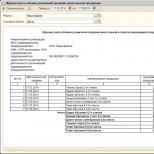Kitchen worker: job responsibilities. Kitchen Worker Kitchen Worker Qualification Handbook
Unified tariff and qualification reference book of jobs and professions of workers (ETKS). Edition No. 51
Approved by the Resolution of the Ministry of Labor of the Russian Federation of 05.03.2004 N 30
Kitchen worker
Section 15. Kitchen worker of the 2nd category
Description of works... Delivery of semi-finished products and raw materials to production workshops. Opening barrels, boxes, bags with food, opening glass and tin cans, ensuring the safety of products in them. Unloading products from containers. Intrashop transportation of raw materials, semi-finished products, food, dishes, inventory, containers. Filling boilers with water. Delivery of finished products for distribution or on expedition. Loading of functional containers with products for the external network, loading them onto transport. The inclusion of electric, gas boilers, stoves, cabinets, boilers. Installation of trays on the conveyor when picking up meals. Placement on trays of cutlery, bread, plates with cold snacks, glasses of drinks, closing plates, pans with lids. Collection of food waste.
Must know: the name of kitchen utensils, implements, tools and their purpose; rules and methods for opening containers, cans, uncorking barrels; rules for moving products and finished products in production; rules for turning on and off electric boilers, electric stoves, electric cabinets, electric boilers and other types of heating equipment; rules for kindling stoves operating on solid and liquid fuels.
A kitchen worker is a person who works in the kitchen, not as a cook, but as his assistant. Moreover, such an employee must have the same skills and knowledge as the chef himself. The workplace of this specialist is the production workshops of the food unit (blank or pre-production), utility rooms, washing facilities. The duties of a kitchen worker at a food unit can be varied.
Specialist's occupation
What the activity of such an employee mainly specializes in can be determined already from the name. All the work of a specialist is carried out in a kitchen. Kitchen workers help the cook prepare food. They also have their own uniforms. It can be the same as that of the head chef, or different (this is determined by the head of the enterprise).
Chefs alone cannot keep up with everything and prepare food for all visitors. It is for this reason that helpers are so important in the kitchen. But any kitchen worker is legally entitled to potential career advancement to the position of a cook, and in some cases to a chef. Usually such activities are carried out by workers without education or students during their education at an educational institution - in the future this will be a good reason for getting a high-paying job in a restaurant. At this time, a specialist in this profession will already know exactly what is required of him and will do all the work with high quality.
Responsibilities and requirements
Job description - a document, the provisions and rules of which must be observed by every employee carrying out his activities in the kitchen. It is strictly forbidden to violate the provisions of the instructions, since various fines can be issued for this, up to and including dismissal.
Such work activities are classified as blue-collar occupations. For this position, it is allowed to hire only those people who have completed their studies and received vocational education. It may be entry-level. Also, the employee's education can be basic general. Work experience in this case does not play a role, therefore, a person who has never had experience of work in such conditions can be hired for the position. In this case, the main condition of the manager will be the passage of special training, which will help to get used to production and quickly join the work rhythm.
Only the director of the enterprise can accept and appoint to a certain position. He draws up a special order, which is given to the employee for signature.
Important documents
In addition to familiarizing himself with the job description, the kitchen worker must necessarily follow the instructions of the following documents:
- sanitary rules and norms;
- labor protection standards;
- safety rules;
- fire safety rules;
- contract of employment;
- basic rules and regulations in force at the enterprise;
- orders and requirements of the management.

The main duties of a kitchen worker, according to the settings of the instructions, are to have certain skills and knowledge of the following definitions:
- names of dishes;
- the names of the main inventory;
- names of working tools;
- the ability to use all devices and equipment for cooking;
- know how to open containers;
- know how to open preservation;
- be able to independently turn on and off electric boilers, stoves and ovens;
- be able to use thermal devices;
- be able to heat the stove;
- remember the rules that apply to work;
- be able to use personal protective equipment;
- be able to determine where are good products and where are expired;
- follow the rules of business etiquette;
- carefully study the job description;
- be able to transport cargo accurately;
- know the production signaling.
When carrying out labor activities, the employee must perform a number of tasks.

The main duties of the kitchen worker in the dining room:
- transport semi-finished products and raw products to the production workshop;
- open various containers, pots, bags with food;
- carefully open canned foods without damaging them;
- unload goods from containers;
- deliver products from one workshop to another;
- fill boilers with water;
- put products on the distribution table;
- include thermal devices;
- place lunch trays on the conveyor;
- put dishes and cutlery on the table;
- remove food waste;
- cover all plates, glasses and pots in the kitchen;
- carefully monitor your workplace, clean it regularly;
- fill out the accompanying documentation.
What kind of employee should be
All the requirements that the management makes for such specialists are quite simple. Any manager wants to see truly worthy workers in his team.

There are some essential qualities that every kitchen worker should have. Duties of the kitchen worker:
- be clean;
- clearly do their job;
- organize your desktop;
- be distinguished by physical endurance;
- find a common language with the team;
- be able to concentrate;
- be creative.
Such qualities and traits will help you quickly enter the production process, therefore, they are quite important. In addition to personal characteristics, the employee must also have all the required knowledge.
Who the job is not suitable for
Not everyone can get a job in this position, as in any other.

Based on the instructions, there are certain groups of people who are forbidden to get a job in this specialty:
- people with allergies;
- workers who have neuropsychiatric disorders;
- those who have certain problems with the musculoskeletal system;
- people with diseases of the cardiovascular system;
- with difficulties with hearing or visual aids.
The kitchen worker walks a lot during the day, gets very tired, which is physically exhausting. The same cannot be said for cooks who can stand at their workplace all day. It can be precisely determined that such work is quite difficult in physical and moral terms. Before going to get a job for such a position, it is important to correctly match your strengths and be ready to work hard.
2nd category
§ 15. Kitchen worker 2nd grade
Description of the work. Delivery of semi-finished products and raw materials to production workshops. Opening barrels, boxes, bags with food, opening glass and tin cans, ensuring the safety of products in them. Unloading products from containers. Intrashop transportation of raw materials, semi-finished products, food, dishes, inventory, containers. Filling boilers with water. Delivery of finished products for distribution or on expedition. Loading of functional containers with products for the external network, loading them onto transport. The inclusion of electric, gas boilers, stoves, cabinets, boilers. Installation of trays on the conveyor when picking up meals. Placement on trays of cutlery, bread, plates with cold snacks, glasses of drinks, closing plates, pans with lids. Collection of food waste.
Must know: the name of kitchen utensils, implements, tools and their purpose; rules and methods for opening containers, cans, uncorking barrels; rules for moving products and finished products in production; rules for turning on and off electric boilers, electric stoves, electric cabinets, electric boilers and other types of heating equipment; rules for kindling stoves operating on solid and liquid fuels.
From July 1, 2016, employers are required to apply professional standards if the requirements for the qualifications that an employee needs to perform a specific job function are established by the Labor Code, federal laws or other regulatory legal acts (Federal Law No. 122-FZ of May 2, 2015).
To search for approved professional standards of the Ministry of Labor of the Russian Federation, use
Unified tariff and qualification reference book of jobs and professions of workers (ETKS). Edition No. 51
Approved by the Resolution of the Ministry of Labor of the Russian Federation of 05.03.2004 N 30
Kitchen worker
Section 15. Kitchen worker of the 2nd category
Description of works... Delivery of semi-finished products and raw materials to production workshops. Opening barrels, boxes, bags with food, opening glass and tin cans, ensuring the safety of products in them. Unloading products from containers. Intrashop transportation of raw materials, semi-finished products, food, dishes, inventory, containers. Filling boilers with water. Delivery of finished products for distribution or on expedition. Loading of functional containers with products for the external network, loading them onto transport. The inclusion of electric, gas boilers, stoves, cabinets, boilers. Installation of trays on the conveyor when picking up meals. Placement on trays of cutlery, bread, plates with cold snacks, glasses of drinks, closing plates, pans with lids. Collection of food waste.
Must know: the name of kitchen utensils, implements, tools and their purpose; rules and methods for opening containers, cans, uncorking barrels; rules for moving products and finished products in production; rules for turning on and off electric boilers, electric stoves, electric cabinets, electric boilers and other types of heating equipment; rules for kindling stoves operating on solid and liquid fuels.
How to correctly make an entry in the work book: accepted by a kitchen worker or kitchen worker, if according to the staffing table the position is called "kitchen worker", while the order says: accepted by the kitchen worker. The rest we prescribe accepted for the position ... and then indicate in the nominative case, the title of the position according to the staffing table, but the personnel officer was in difficulty, because you cannot write about the kitchen worker that this is a position
Answer
Your question is related to the application of ETKS.
Positions in ETKS are named only in masculine gender: for example, janitor, not janitor; a worker, not a worker.
ETKS is obligatory for use in all sectors of the economy, where there are works provided for by this or that issue. You can find similar explanations on the websites of regional labor inspectorates (see, for example, http://git24.rostrud.ru/questioner/xPages/section.90/page.123.html, question dated February 20, 2012 18:19).
Therefore, it is correct: "Adopted by the kitchen worker."
The rationale for this position is given below in the materials of the Glavbukh System
ETKS (Issue 51)
"§ 15. Kitchen worker *
2nd category
Description of the work. Delivery of semi-finished products and raw materials to production workshops. Opening barrels, boxes, bags with food, opening glass and tin cans, ensuring the safety of products in them. Unloading products from containers. Intrashop transportation of raw materials, semi-finished products, food, dishes, inventory, containers. Filling boilers with water. Delivery of finished products for distribution or on expedition. Loading of functional containers with products for the external network, loading them onto transport. The inclusion of electric, gas boilers, stoves, cabinets, boilers. Installation of trays on the conveyor when picking up meals. Placement on trays of cutlery, bread, plates with cold snacks, glasses of drinks, closing plates, pans with lids. Collection of food waste.
Should know: the name of the kitchen utensils, implements, tools and their purpose; rules and methods for opening containers, cans, uncorking barrels; rules for moving products and finished products in production; rules for turning on and off electric boilers, electric stoves, electric cabinets, electric boilers and other types of heating equipment; rules for kindling stoves operating on solid and liquid fuels. "
* This is a highlighted part of the material that will help you make the right decision.





